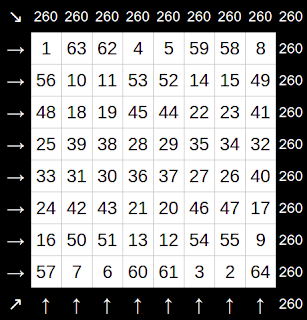 |
| Legge, 1879 |
 Hexagrams are composed of a trigram pair arranged in superposition: lower and upper, or inner and outer. The places are numbered 1 through 6 from bottom to top. Therefore, we can depict an hexagram using our unit square wireframe diagram by connecting any two vertices with directed paths. The syntax for this poses the original vertex as lower trigram, the terminal vertex as upper.
Hexagrams are composed of a trigram pair arranged in superposition: lower and upper, or inner and outer. The places are numbered 1 through 6 from bottom to top. Therefore, we can depict an hexagram using our unit square wireframe diagram by connecting any two vertices with directed paths. The syntax for this poses the original vertex as lower trigram, the terminal vertex as upper.For example, the directed path leading from (1,1,0) to (0,0,1) gives ䷨ hexagram #41, Reduction. Reversing the direction of the path produces ䷩ hexagram #42, Increase.Each of the eight vertices has seven outbound paths to each of the other vertices, totaling 56 paths. Half of these paths are duplicates, in the sense that the paths connect the same pair of trigrams; thus, the 56 paths comprise 28 pairs of heterogenous* hexagrams. Each vertex can also loop back to itself. These 8 loops constitute 4 pairs of homogenous* hexagrams. An outbound path and its reversal constitute a Wen Pair; loops at antipodal corners (e.g. the example given above) also designate Wen pairs.
*The terms heterogenous and homogenous (applied to hexagrams) refer to the constituent trigrams
Given the yao-numbers derived from Wen's hexagram pairs, we are enabled to assign a weighting to each path, and treat the paths as proper vectors.








